18 Oct Table Mountain — Stairway to Heaven, Almost
Table Mountain in South Africa is made from a species of very hard sandstone called, naturally enough, Table-Mountain sandstone. Rumor has it there’s another half to Table Mountain on the coast of Brazil . . . sheared off when pieces of Gondwanaland went their separate ways.
To my mind, the South African part got the better end of the deal. It’s at the very foot of the continent where moist, semi-tropical air from the Indian Ocean drifts across the top, encounters cold, South Atlantic air and condenses into what locals call the Tablecloth.
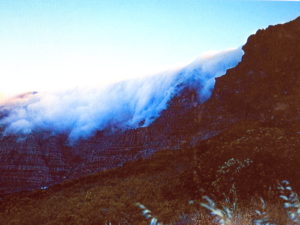
The sight is wild and romantic and raises thoughts of the ancient, Edenic Africa we all carry within ourselves. Looking up at it day after day for twenty-three years must have been a special torture to Nelson Mandela stuck on Robben Island.
You wouldn’t think Table Mountain would be hard to climb. It’s only 3501 feet high, barely more than a hill, and people climb hills all the time. Besides, it’s an urban hill with Cape Town spread along the bottom and around the side and the back.
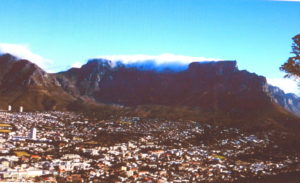
A midday stroll, you tell yourself.
If António de Saldanha could climb the thing in 1503, getting to the top should be a snap. I mean, who had the better nutrition? A Portuguese explorer who’d been on a tiny ship for months eating hardtack and salt pork? Or a modern, twenty-first century guy munching his way through the food pyramid? For that matter, which one of us had the better chance to hike around and build up his leg muscles? And who has the Nikes? There are plenty of trails up Table Mountain, but Peggy and I decided to take the stairs.
We should have thought this through a bit more. It’s one thing to hike on a trail. On a trail you just swing your legs and the momentum carries you along. On stairs, you have to lift a leg every time you take a step which, for a 3,501-foot climb, comes to 4,829 leg lifts, if the steps are OSHA compliant. Which, on Table Mountain, they aren’t.
Peggy looked at that endless flight of steps and had the only sensible thought we had all morning. “Water,” she said. “We’ll need water.”
Water sounded like a luxury to me. It also sounded heavy. But she wasn’t persuaded, and caught a taxi and came back with three bottles of water.
They didn’t last half an hour. But he steps did.
And another hour.
And an hour after that. Not so much time by mountain-hiking standards. But more than enough for stair climbing, thank you very much.
On the plus side, the view was lovely, and not just for things in the distance, but up close, too. Which gave me plenty of excuses to stop and look around. Table Mountain has a greater variety of plant life than the entire United Kingdom.
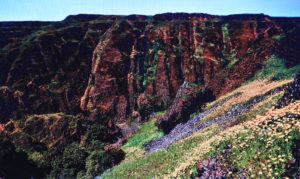
It also has more steps. Many, many more steps than could possibly be in the UK, even if you tossed in several of the former colonies.
About two-hundred yards from the top my leg muscles reached refusal. It didn’t have anything to do with trying or willpower. It had to do with lactic acid and my muscles just quit.
I tried sitting down, and sitting helped in the sense that it was better than standing. But once your legs lock into the sitting position, there you are.
I’d still be sitting there, admiring the sheer sheerness of it all

if a couple who’d taken the cable car up hadn’t passed us on the way down and told me, “No worries, Mate, There’s a Coca-Cola stand at the top.
A Coca-Cola was waiting for me on the top of Table Mountain.
Maybe more than one Coca-Cola. As an Atlanta boy, I had never been so proud of our hometown drink.
I still couldn’t walk because I still couldn’t lift my legs high enough to reach the next step, but I could scramble. Tilted forward like an eighteen-month-old pawing at the steps, I made my way up those last two-hundred yards. For some reason that has never made sense, Peggy was already at the top.
Maybe the stories are true about what they put in Coca-Cola, I don’t know. Maybe in South Africa they still put it in, but whatever was in that drink was just what my muscles needed. And it didn’t hurt that the steps were behind us and that it was flat up there. Paused and refreshed, we set out to explore.
There’s a trail that runs the entire length of the top of the Table Mountain: from the cable car station at one end to the observatory on the other. That seemed an odd place for an observatory given how often the tablecloth settles in, and I’m pretty sure it hasn’t been used for years. I don’t remember exactly what it was supposed to have observed, but I came away with the impression it had something to do with lines of longitudes. Or, maybe, solar eclipses.
What I could have anticipated, but didn’t, was that Table Mountain, being flat and moist from the tablecloth, a lot of water would have accumulated up there. Which makes it the only mountain I’ve ever been on with its own, mountaintop swamp.
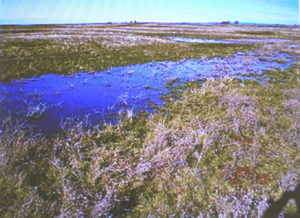
There were bull rushes rustling and frogs chirping and, in some places, the trail was boards laid in the mud like people use to get around in tourist swamps.
The day we were there the tablecloth was folded and stored away and we could look over the side and see the Atlantic. Or the other side and see the Indian Ocean. Or off the end and see the Cape of Good Hope, and the Indian Ocean, and the Atlantic all coming together,
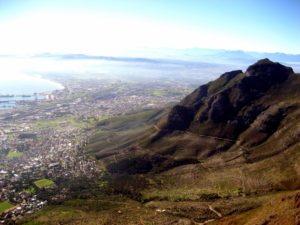
and think of Vasco da Gama and Mandela and Bartolomeu Dias and the San people who used to live around there.
We could imagine Portuguese ships bringing home spices. And British ships filled with teas and silks. And other British ships transporting convicts around the Cape of Good Hope to a life in Australia that proved much better than the slums they’d been pulled out of.
From the observatory we walked back across the mountain, and through the swamp past the Coke stand, and took the cable car to the bottom.
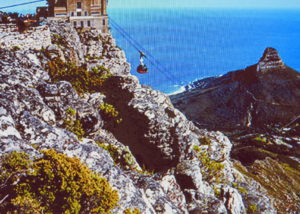
We considered walking but dismissed the thought as the crackpot idea it was.


No Comments